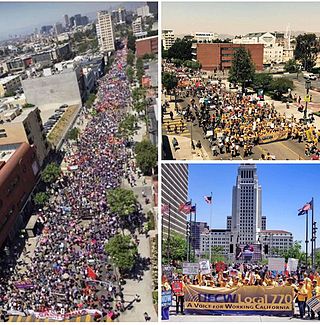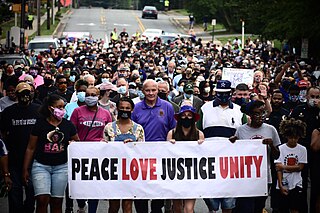
A black bloc is a tactic used by protesters who wear black clothing, ski masks, scarves, sunglasses, motorcycle helmets with padding or other face-concealing and face-protecting items. The clothing is used to conceal wearers' identities and hinder criminal prosecution by making it difficult to distinguish between participants. It is also used to protect their faces and eyes from pepper spray, which is used by police during protests or civil unrest. The tactic also allows the group to appear as one large unified mass. Black bloc participants are often associated with anarchism, anarcho-communism, communism, libertarian socialism and the anti-globalization movement. A variant of this type of protest is the Padded bloc, where following the Tute Bianche movement protesters wear padded clothing to protect against the police.

A police riot is a riot carried out by the police; more specifically, it is a riot that police are responsible for instigating, escalating or sustaining as a violent confrontation. Police riots are often characterized by widespread police brutality, and they may be done for the purpose of political repression.
Black Friday, August 13, 2004, was the crackdown by the Maldivian National Security Service (NSS) — later Maldivian National Defence Force — on a peaceful protest in the capital city of Maldives, Malé. This unplanned and unorganized demonstration was the largest such protest in the country's history. Beginning on the evening of August 12, 2004, the demonstration grew and continued until it was forcefully ended on the afternoon of August 13, 2004. Protesters initially demanding the freeing of the pro-reformists arrested on the afternoon of August 12, 2004. As the protest continued to grow, people demanded the resignation of president Maumoon Abdul Gayoom, who had been in power since 1978. What started as a peaceful demonstration ended after 22 hours, as the country's darkest day in recent history. Several people were severely injured as NSS personnel used riot batons and teargas on unarmed civilians.
The 2005 Maldivian civil unrest refers to the civil unrest that broke out in Malé, Gaafu Dhaalu Atoll and Addu Atoll of the Maldives on August 12, 2005, which led to events that supported the democratic reform of the country. This unrest was provoked by the arrest of Mohamed Nasheed - an open critic of the president Maumoon Abdul Gayoom - and the subsequent demolition of the Dhunfini tent, used by the members of the Maldivian Democratic Party (MDP) for their gatherings. Supporters of MDP were quick to demonstrate. They started calling for the resignation of Maumoon Abdul Gayoom, soon after Nasheed's arrest. Several arrests were made on the first night followed by the demolition of the Dhunfini tent. The demolition complicated the situation further provoking the unrest. The unrest grew violent on the third night, on August 14, 2005, due to the methods used in the attempts by the authority to stop the demonstration.
The 2009 May Day protests were a series of international protests that took place across Europe, Asia and in the other parts of the world due to the financial crisis of 2007–2008 and the resulting Great Recession. Several May Day marches, which are traditional events, had turned violent in Germany, Turkey and Venezuela as riot police battled protesters in their respective countries. Banks and shops had been attacked in Turkey.
The word serhildan describes several Kurdish protests and uprisings since the 1990s that used the slogan "Êdî Bese" ("Enough") against Türkiye. Local shops are often closed on the day of demonstrations as a form of protest.
Riots in Detroit, Michigan, have occurred since the city was founded in 1701. This area was settled by various ethnicities following thousands of years of indigenous history. During the colonial period, it was nominally ruled by France and Great Britain before the border was set in the early 19th century and it became part of the United States. The first riot, social unrest related to enabling fugitive slaves to escape to Canada, was recorded in 1833. Other riots were related to business protests, unions, and other issues.
The 2011–2012 Kurdish protests in Turkey were protests in Turkey, led by the Peace and Democracy Party (BDP), against restrictions of Kurdish rights by of the country's Kurdish minority's rights. Although they were the latest in a long series of protest actions by Kurds in Turkey, they were strongly influenced by the concurrent popular protests throughout the Middle East and North Africa, and the Turkish publication Hürriyet Daily News has suggested that the popularly dubbed "Arab Spring" that has seen revolutions in Egypt and Tunisia may lead to a "Kurdish Summer" in the northern reaches of the Middle East. Protesters have taken to the streets both in Istanbul and in southeast Turkey, with some demonstrations also reported as far west in Anatolia as İzmir.
The 2011–2013 Maldives political crisis began as a series of peaceful protests that broke out in the Maldives on 1 May 2011. They would continue, eventually escalating into the resignation of President Mohamed Nasheed in disputed circumstances in February 2012. Demonstrators were protesting what they considered the government's mismanagement of the economy and were calling for the ouster of President Nasheed. The main political opposition party in the country, the Dhivehi Rayyithunge Party led by the former president of the country Maumoon Abdul Gayoom accused President Nasheed of "talking about democracy but not putting it into practice." The protests occurred during the Arab Spring.

On April 12, 2015, Baltimore Police Department officers arrested Freddie Gray, a 25-year-old African American resident of Baltimore, Maryland. Gray's neck and spine were injured while he was in a police vehicle and he went into a coma. On April 18, there were protests in front of the Western district police station. Gray died on April 19.

On November 10, 2016, three days of protests in Portland, Oregon, turned into a riot, when a group of anarchists broke off from a larger group of peaceful protesters who were opposed to the election of Donald Trump as president of the United States.
From November 9–12, 2016, protests occurred in Oakland, California, against the election of Donald Trump. While originally peaceful, these protests became violent, with protesters lighting trash cans and cars and a building on fire and smashing store windows and throwing bottles at police. Thirty protesters were arrested, and three officers were injured.
The 2014 Oakland riots were a series of riots and civil disturbances that took place in Oakland, California and surrounding areas in November and December 2014. On November 24, 2014, following the decision of a Grand Jury in St. Louis to not charge Darren Wilson in the shooting death of black teenager Michael Brown, protests and rioting broke out in Oakland and later spread to other Bay Area cities. For more than two weeks, the Bay Area was the site of civil unrest as protesters clashed with police and damaged public and private property.

The 2017 May Day protests were a series of protests that took place on May Day over worker and immigrant rights, throughout the United States and around the world. Protests became violent in Olympia, Washington, and Portland, Oregon. Many demonstrators were protesting against the policies of President Donald Trump, specifically those related to immigration.

The sentencing of nine Catalan independence leaders in a 2019 trial by the Supreme Court of Spain triggered protests in Catalonia. They were convicted of sedition and other crimes against the Spanish state for their role in the organization of the 2017 Catalan independence referendum.

The city of Seattle experienced protests over the murder of George Floyd in 2020 and 2021. Beginning on May 29, 2020, demonstrators took to the streets throughout the city for marches and sit-ins, often of a peaceful nature but which also devolved into riots. Participants expressed opposition to systemic racism, police brutality and violence against people of color.

This is a list of George Floyd protests in North Carolina, United States.

This is a list of protests held in Wisconsin, related to the murder of George Floyd, during 2020. Additional protests occurred in late August in Kenosha, Wisconsin in the aftermath of the shooting of Jacob Blake. Protests also occurred in 2020 in Wauwatosa, Wisconsin during the aftermath of the shooting of Alvin Cole.








